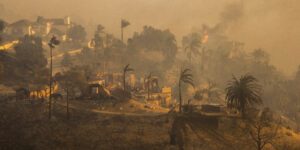The world’s cities are a big driver of planet-warming emissions but can play a major role in addressing climate change in the near future.
U.N. scientists on Monday laid out ways to rein in emissions and curb climate change, including a chapter on actions that city planners can follow.
The Intergovernmental Panel on Climate Change report found urban infrastructure and activities caused about two-thirds of today’s emissions.
That means cities can potentially “solve two-thirds of the problem. So, that’s pretty exciting,” said Yale University geographer Karen Seto, a lead author of the chapter.
Many cities are already acting. London has introduced fees on highly polluting vehicles in the city center, and Paris has outlawed diesel cars.
Other actions cities can take include improving energy efficiency in buildings, designing streets to avoid traffic congestion, planting “green roofs,” and incorporating more parks and trees that help remove some carbon dioxide emissions and also help to keep cities cooler, the report said.
Planning for and encouraging population density is recommended to prevent rural and suburban sprawl, which is less energy efficient and destroys natural habitats.
“The 21st-century will be the urban century, defined by a massive increase in global urban populations,” the report said. About 55 percent of the world’s population lived in cities in 2018, a figure expected to jump to 68 percent by 2050—with Asian and African cities seeing the biggest increases.
Climate-friendly urban policies would also improve public health by reducing air pollution, the report said.
For the world to have a chance of limiting global warming to within 1.5 degrees Celsius (2.7 degrees Fahrenheit) of pre-industrial levels, cities need to act fast—and financing would need to be boosted significantly, the report says.
Cities in 2020 were responsible for up to 72 percent of global greenhouse gas emissions, up from 62 percent in 2015. Aggressive climate action could bring city emissions to net-zero by 2050. But failing to act could instead see urban emissions double in that time, the report said.
(Reporting by Daniel Trotta; Editing by Donna Bryson, Leslie Adler, Katy Daigle and Barbara Lewis)




















 U.S. Insurance Deals Outlook: More, More, More
U.S. Insurance Deals Outlook: More, More, More  Reporter’s Notebook: ‘Nobody Else Does Telematics,’ Lemonade Exec Says
Reporter’s Notebook: ‘Nobody Else Does Telematics,’ Lemonade Exec Says  New Specialty Insurer Says Collector Car Owners Are Being Overcharged
New Specialty Insurer Says Collector Car Owners Are Being Overcharged  Property and Casualty Insurance Trends for 2025
Property and Casualty Insurance Trends for 2025 




